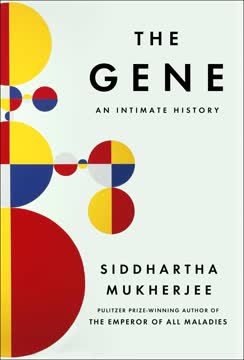Key Takeaways
1. Understanding the Science of Cooking Enhances Culinary Skills
The more fully we know our foods, the better we can choose them and cook with them.
Chemistry in the kitchen. Understanding the basic chemical composition of foods - water, proteins, carbohydrates, and fats - provides insights into how they behave during cooking. For example, proteins coagulate when heated, which is why eggs solidify and meats become firm. Carbohydrates absorb water and dissolve, explaining how starches thicken sauces and why vegetables soften when cooked.
Physics of cooking methods. Different cooking methods transfer heat in various ways:
- Conduction: Direct contact (e.g., pan-frying)
- Convection: Circulation of hot air or liquid (e.g., oven roasting, boiling)
- Radiation: Heat waves (e.g., broiling, microwaving)
Understanding these principles allows cooks to choose the best method for each ingredient and desired outcome. For instance, slow, moist cooking methods are ideal for tough cuts of meat to break down connective tissue, while quick, high-heat methods work best for tender cuts to preserve juiciness.
2. Prioritize Food Safety to Prevent Illness
Careless handling at any stage can contaminate them with various disease bacteria, including salmonella, listeria, and E. coli.
Proper food handling. Food safety begins with proper handling and storage. Keep raw meats separate from other foods to prevent cross-contamination. Store perishables at appropriate temperatures: below 40°F (4°C) for refrigerated items and 0°F (-18°C) for frozen foods. Always wash hands thoroughly before and after handling food, especially raw meats.
Safe cooking temperatures. Use a food thermometer to ensure foods reach safe internal temperatures:
- Poultry: 165°F (74°C)
- Ground meats: 160°F (71°C)
- Whole cuts of beef, pork, lamb: 145°F (63°C) with a 3-minute rest time
- Fish and shellfish: 145°F (63°C)
Remember the "danger zone" between 40°F and 140°F (4°C to 60°C) where bacteria multiply rapidly. Don't leave perishable foods out at room temperature for more than 2 hours (1 hour if the temperature is above 90°F/32°C).
3. Master the Art of Cooking Meats to Perfection
Searing meat does not seal in its juices, and moist cooking methods do not make meats moist. Juiciness depends almost entirely on how hot you cook the center of the meat.
Temperature control is key. The secret to juicy, tender meat lies in precise temperature control. Use a meat thermometer to monitor internal temperatures and remove the meat from heat when it reaches 5-10°F (3-6°C) below the desired final temperature, as it will continue cooking during resting.
Cooking methods for different cuts:
- Tender cuts (e.g., steaks, chops): High-heat methods like grilling or pan-searing
- Tough cuts (e.g., brisket, chuck): Slow, moist cooking methods like braising or stewing
Resting is crucial. Always let meat rest after cooking to allow juices to redistribute. The resting time should be about 5-10 minutes for small cuts and up to 20-30 minutes for large roasts. This step ensures maximum juiciness and easier carving.
4. Unlock the Potential of Vegetables and Herbs
Cooking generally softens vegetable texture, deepens flavor, increases the availability of some nutrients while reducing the levels of others, and eliminates microbes.
Cooking methods affect nutrition. Different cooking methods can enhance or diminish the nutritional value of vegetables. Steaming and microwaving generally preserve more nutrients than boiling, which can leach water-soluble vitamins into the cooking water. Roasting and grilling can enhance flavor through caramelization but may reduce some heat-sensitive nutrients.
Herb handling tips:
- Store herbs properly: Wrap in damp paper towels and refrigerate
- Add delicate herbs (e.g., basil, cilantro) at the end of cooking to preserve flavor
- Use hardy herbs (e.g., rosemary, thyme) earlier in the cooking process
Vegetable preparation techniques:
- Blanching: Briefly boil then plunge into ice water to preserve color and texture
- Shocking: Immerse in ice water after cooking to stop the cooking process
- Julienning: Cut into thin strips for quick cooking and attractive presentation
5. Elevate Your Cooking with Eggs and Dairy
Eggs are as common a food as we've got, but that's because they're also one of the most extraordinary.
Versatility of eggs. Eggs are culinary chameleons, serving multiple functions in cooking:
- Binding: Hold ingredients together in meatloaves and casseroles
- Leavening: Provide structure and lift in soufflés and cakes
- Emulsifying: Stabilize mixtures like mayonnaise and hollandaise sauce
- Glazing: Create a golden sheen on baked goods
- Thickening: Add body to custards and sauces
Dairy in cooking. Milk, cream, and cheese add richness, flavor, and texture to dishes:
- Milk: Adds moisture and helps bind ingredients
- Cream: Provides richness and can be whipped for aeration
- Cheese: Adds flavor, protein, and can be used as a thickener or topping
Temperature control for eggs and dairy. Proper temperature management is crucial:
- Eggs: Cook to 160°F (71°C) for safety, but lower temperatures (around 145°F/63°C) produce creamier textures in dishes like custards
- Dairy: Heat milk and cream gently to avoid curdling; use low temperatures when melting cheese to prevent separation
6. Explore the World of Grains, Legumes, and Breads
Grains and their legume-family relatives are main-course seeds, even more so than the grains. They can't make raised breads or chewy pastas the way grains do, but they're the heart of the meal in many parts of the world for people who don't have access to meat or choose not to eat it.
Cooking grains and legumes. Proper preparation is key to unlocking the nutritional value and flavor of grains and legumes:
- Soaking: Reduces cooking time and improves digestibility
- Cooking ratios: Generally 2 parts liquid to 1 part grain, but varies by type
- Cooking methods: Boiling, steaming, pressure cooking, or using a rice cooker
Bread-making basics:
- Ingredients: Flour, water, yeast, salt (and sometimes sugar, fat, or eggs)
- Kneading: Develops gluten for structure (can be replaced by long, slow fermentation)
- Rising: Allows yeast to produce CO2, creating a light texture
- Shaping: Determines final appearance and texture
- Baking: High heat sets structure and creates crust
Exploring variety. Experiment with different grains and legumes for diverse flavors and textures:
- Ancient grains: Quinoa, amaranth, millet, teff
- Whole grains: Brown rice, whole wheat, oats
- Legumes: Lentils, chickpeas, black beans, soybeans
7. Perfect the Craft of Pastry and Pie Making
Pastries offer the pleasures of dryness, the crisp and crumbly and flaky and browned.
Key principles of pastry making:
- Keep ingredients cold: Prevents fat from melting prematurely
- Minimal handling: Reduces gluten development for tender results
- Proper hydration: Balance of flour and liquid for ideal texture
Types of pastry:
- Flaky: Layers of dough separated by fat (e.g., pie crust, puff pastry)
- Shortcrust: Crumbly texture from fat worked into flour (e.g., tart shells)
- Choux: Light and airy from high moisture content (e.g., eclairs, cream puffs)
Pie-making tips:
- Blind baking: Pre-bake crust for wet fillings to prevent sogginess
- Thickeners: Use cornstarch, tapioca, or flour to set fruit fillings
- Egg wash: Brush crust with beaten egg for golden color
- Venting: Cut slits in top crust to allow steam to escape
Master these techniques, and you'll be able to create a wide range of delicious pastries and pies, from savory quiches to sweet fruit tarts and everything in between.
Last updated:
FAQ
What's Keys to Good Cooking about?
- Comprehensive Guide: Keys to Good Cooking by Harold McGee is a detailed exploration of cooking techniques and food science, designed to improve culinary skills.
- Science Focus: The book emphasizes understanding the science behind cooking, explaining how ingredients and methods interact for better outcomes.
- Practical Tips: It offers practical advice for both novice and experienced cooks, covering a wide range of topics from basic to advanced techniques.
Why should I read Keys to Good Cooking?
- Enhance Skills: Reading this book can significantly improve your cooking skills by providing insights into the science of food.
- Critical Companion: It serves as a critical companion to your recipe collection, helping you evaluate and adapt recipes effectively.
- Versatile Resource: Suitable for both beginners and experienced cooks, it covers a wide array of topics, making it a valuable resource.
What are the key takeaways of Keys to Good Cooking?
- Understanding Ingredients: Knowing your ingredients, including their histories and qualities, is crucial for selecting the best ones for your dishes.
- Cooking Methods Matter: Different methods yield different results; understanding them helps you choose the right one for your dish.
- Safety and Quality: Emphasizes food safety and proper handling to prevent foodborne illnesses, providing guidelines for safe cooking practices.
How does Keys to Good Cooking explain the science behind cooking?
- Chemical Reactions: McGee delves into chemical reactions like caramelization and Maillard reactions, helping achieve desired flavors and textures.
- Temperature Control: Discusses how temperature affects cooking outcomes, crucial for mastering various techniques.
- Ingredient Interactions: Explains how ingredients interact during cooking, influencing flavor and texture, allowing for harmonious dishes.
What cooking methods are discussed in Keys to Good Cooking?
- Moist and Dry Methods: Categorizes methods into moist (boiling, steaming) and dry (baking, frying), each suited for different foods.
- Temperature Control: Highlights the significance of temperature control, affecting texture and flavor.
- Practical Techniques: Provides practical techniques and tips for achieving the best results with each method.
How does Keys to Good Cooking address food safety?
- Microbial Risks: Discusses risks of foodborne illnesses from harmful microbes on raw foods, emphasizing careful handling.
- Safe Practices: Outlines safe cooking practices, like keeping raw meats separate and cooking to appropriate temperatures.
- Storage Guidelines: Provides guidelines for storing foods safely to prevent spoilage and contamination.
What are some common misconceptions about cooking that Keys to Good Cooking addresses?
- Searing Myths: Clarifies that searing meat does not seal in juices, debunking a common misconception.
- Cooking Times: Emphasizes that most recipes can't predict correct cooking times; checking for doneness is essential.
- Ingredient Quality: Addresses the misconception that all ingredients are equal, explaining quality variations based on production and freshness.
How does Keys to Good Cooking help with ingredient selection?
- Evaluating Quality: Provides guidance on evaluating the quality of ingredients like fruits, vegetables, and meats.
- Understanding Production: Discusses production methods and their impact on quality, encouraging informed choices.
- Seasonal Choices: Encourages choosing seasonal and local ingredients for better quality and flavor.
What are the best quotes from Keys to Good Cooking and what do they mean?
- "Cooking is especially rewarding...": Highlights the joy from successful cooking, focusing on understanding and improving skills.
- "A good recipe can be badly made.": Emphasizes that understanding the process and adapting it is crucial for success.
- "The most important kitchen facts...": Suggests that essential cooking principles require deeper exploration, encouraging critical thinking.
How can I apply the principles from Keys to Good Cooking in my kitchen?
- Experiment and Adapt: Use the knowledge to experiment with methods and adapt recipes to your tastes and ingredients.
- Focus on Understanding: Apply principles of understanding food and processes to improve skills and troubleshoot issues.
- Regular Review: Regularly review early chapters to refresh understanding of tools, safety, and methods.
What tips does Keys to Good Cooking offer for baking?
- Measuring Accurately: Emphasizes precise measurements, recommending a kitchen scale for accuracy.
- Oven Temperatures: Provides insights on calibrating and understanding oven temperatures for optimal results.
- Baking Techniques: Covers techniques like preheating pans and using the right materials for the best rise and texture.
How can I improve my frying skills according to Keys to Good Cooking?
- Maintain Temperature: Stresses keeping the pan hot enough to sizzle constantly, preventing sogginess and ensuring browning.
- Avoid Overcrowding: Advises against overcrowding the pan, which can lower temperature and lead to uneven cooking.
- Use Right Fats: Discusses selecting the right fats for frying, as different oils have different smoke points and flavors.
Review Summary
Keys to Good Cooking receives mixed reviews. Many praise it as an invaluable reference for home cooks, offering scientific insights and practical tips to improve cooking skills. Readers appreciate the comprehensive coverage of ingredients, techniques, and kitchen tools. However, some find the writing dry and repetitive, noting that experienced cooks may not learn much new information. Critics argue the book lacks depth in certain areas and can be overwhelming. Despite these criticisms, most reviewers consider it a useful resource for understanding the science behind cooking and troubleshooting recipes.
Similar Books







Download PDF
Download EPUB
.epub digital book format is ideal for reading ebooks on phones, tablets, and e-readers.





